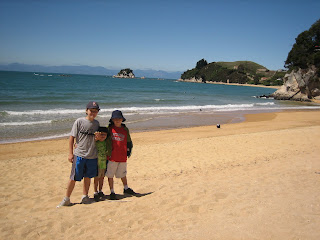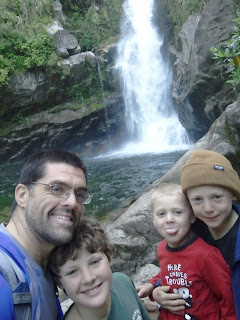I just saved 15 pictures to this post but they all just dissappeared but one. I am going to put them in another post tomorrow because it is very time consuming. Sorry readers, you will have to wait for the visuals. - Suz
We are back from our trip to the Nelson region and the Golden Bay and what a journey. First, though New Zealand is a small island, do not be deceived, it is a long way to travel to the northern tip of the south island. We took the island scenic route to Nelson on the way up and that was about an eight hour drive. It was about an eleven hour drive from even further north, Takaka, by the coastal route on the way home. The kids did great in the car, singing songs, telling stories, looking at the magnificent scenery and hitting each other. (They are boys.)
It is hard to describe the scenery it is so majestic. Everywhere in the south island, the snowcapped mountains of the Southern Alps are a figure imposing on the landscape. Whether they are in the distance on the Canterbury plains or closer off the rolling pastured foothills they are ever present, stark and rocky. On this trip, we drove right through them on the inland route via Lewis Pass. On the other side other mountain ranges took over. These were green, lush rainforests Nelson Lakes National Park, Khangarai National Park, and finally where we hiked twice, the smallest national park in NZ, but perhaps the most famous, Abel Tasman National Park.
Nelson is a small, artsy town/city. In the morning there was the Saturday market right next to the youth hostel where we were staying and there were tons of stalls with craftsmans showing their wares. We browsed around there for an hour or so and then drove an hour out to Kaiteritei Beach where we caught a boat that took us into the Abel Tasman National Park. The beach was white sands and aquamarine blue seas. The views from on the boat ride were stunning, though we did have to hold on tight as this was not protected water, but open ocean. Walking while the boat was moving was not for the faint hearted. The boat dropped us on the shore and we hiked the well groomed, gentle coastal track for two and a half hours. We saw a water fall and a huge tidal lagoon, what looked like a Mediterranean beach inlet with crystal clear green, blue waters. All the time we were in a jungle rain forest with the beach down a steep drop off on one side. It was a perfect paradise. Our way back to the youth hostel we stopped for Thai food in the hopping town of Moetueka and then headed off back to the youth hostel. Happy and tired.
The next day we left Nelson and drove out to stay in the Golden Bay region itself in the town of Takaka. This is about three hours from Nelson and required us to travel over Takaka Hill. It is not a hill but another huge mountain and though it seemed impossible the lush rainforest became even lusher on the other side. We stopped at Ngara caves on the way. The whole area covers series of underground cave systems. The Ngara caves were first discovered by a 17 year old in 1786 who thought it would be fun to go into a hole in the ground exploring with only a candle. (It takes a 17 year old boy to have a thought like that.) Now the all __ km of the system has been explored and prepared so that tourists can go down. It was tremendously impressive with its stalactites and stalagmites which take thousands of years to meet up. At one point the guide turned out all the lights and boy was it dark. There was also a chance to see and hold moa bones. These are now extinct ground birds which grew to heights of up to 9 feet tall on their backs. With no natural predators here in NZ many birds became flightless. When the Maori arrived about 1000 years ago, the moa were hunted to exctinction (by the 1500's) and the birds that lived on them also. Because they were flightless, the bones were very heavy.
Takaka was a neat little town. A small rural town, heavy in hippie influence with organic grocery stores and restaurants. I liked it a lot, but it would be hard to live there so far from everything. The nearest next town over the "hill" an hour away. We got to Annies Nirvana Youth Hostel and prepared for Ruby's fifth birthday which was the next day. Travelling or not, you are only five once. Because he is allergic to wheat, eggs, soy, and most other edible food groups, I had to bring premade special cake batter with us and make him a cake in the hostel. We brought presents and made his birthday in the morning. It was a little unorthodox, but I think he was very happy. He was in "Nirvana" after all.
That day we went to see the Waikaropupu Springs first (Called PuPu springs for short). These are springs which are sacred to the Maori and which can't be touched by human hands, bottles, rods, boats or anything according to the Dept of Conservation. With the exception of a known spring under the ice cap in Antarctica they are the cleanest water source on the planet. The main spring puts out the equivalent 40 bathtubs full of water every second. There is also a secondary spring called Dancing Sands because it is always kicking up sand as it discharges water. That spring is over 9 feet underwater, but looks just under the surface. The springs are in an area that was once completely burned of foliage when goldmining was underway in the 1800's, but is now in various stages of regrowth and is marked, so that was really interesting to read about and see a NZ forest in various stages from beginning to mature. Then we went to a salmon farm and caught our own salmon and ate it smoked. Next door was an animal park and in the park is the Anatoki River where a wild population of eels has been handfed since 1914 by this one lady (now deceased). The eels which can live over 100 years still come to the spot and allow themselves to be fed raw meat on a stick which we did. Very cool. Sam touched them as well.
After that (yes there was more, we drove all the way out to what felt like nearly the end of the south island, past a town called Pohara (the end is actually called Farewell Spit. We didn't get there.) There we hiked to a waterfall inside a different part of the Abel Tasman National Park. To get there, we had to cross a swing bridge - a bridge made only of cables. This was a feat of great courage because it could only be crossed one at a time. This meant I had to let Ruby cross alone. I don't know who needed more courage, him or me. He looked like it was no big deal. I was sweating bullets. When we reached the waterfall, it was like a scene out of a book. I mist of water vapor rose off of the clear, green water at the bottom of the great water fall. A stillness was in the rhythmic pounding of the water. I expected fairies or elves or Aslan to appear any minute, but alas, we were losing light and had to go before they came. We headed back to Nirvana. It was a long great day.
Driving home, we went the longer coastal route, through the wine region of Bleinheim and stopped in Kaikoura District along the road to see the seals who sun themselves along the rocks in the crashing surf of the bright blue green ocean. It is magnificent to see them so close with their pups in the wild. An the scenery is what I have only seen on postcards before. It seems the colors here are more vibrant. I think it is the hole in the ozone that allows in more light and so we see color more vividly. I have never seen ocean water this aquamarine before in my life. I don't think pictures do it justice. And unfortunately I didn't get a good one of it, but you can go here to see what it looks like

Well, this blog post is only slightly shorter than our drive home, but I hope it gave you a flavor for the Golden Bay and Nelson Region. So far as we have travelled, my consistent thought is I wish we had more time in every single one spot. There is so much to do and see. But perhaps we will get back here during this year. It is well worth a second trip.
 This is a shot of Sumner from the Captain Thomas Walking track in the hills behind it. Steve was working an evening shift, and we had the chance to hike during the day when the kids were at school. As you can see, it is a little place nestled in the hills right on the beach. Our house is by the water on the right side of the picture. The big square of open field is the horse paddock where, next week I will once again resume my horseback riding pursuits. Below is a picture of Steve's newest pursuit. (That is not our house in the back.) I took this as he was walking home for lunch.
This is a shot of Sumner from the Captain Thomas Walking track in the hills behind it. Steve was working an evening shift, and we had the chance to hike during the day when the kids were at school. As you can see, it is a little place nestled in the hills right on the beach. Our house is by the water on the right side of the picture. The big square of open field is the horse paddock where, next week I will once again resume my horseback riding pursuits. Below is a picture of Steve's newest pursuit. (That is not our house in the back.) I took this as he was walking home for lunch. Here is a picture from Ruby's first day of school, with his brother's riding off to school. Aren't they are set in their little school uniforms. It is a brief, wonderous moment in time that all three are in the same school, on the same schedule, walking distance. Ah...in Feburary, Sam will go off to a different school and blow it all out of the water. I will savor the elegance of the school solution till then.
Here is a picture from Ruby's first day of school, with his brother's riding off to school. Aren't they are set in their little school uniforms. It is a brief, wonderous moment in time that all three are in the same school, on the same schedule, walking distance. Ah...in Feburary, Sam will go off to a different school and blow it all out of the water. I will savor the elegance of the school solution till then.


















































